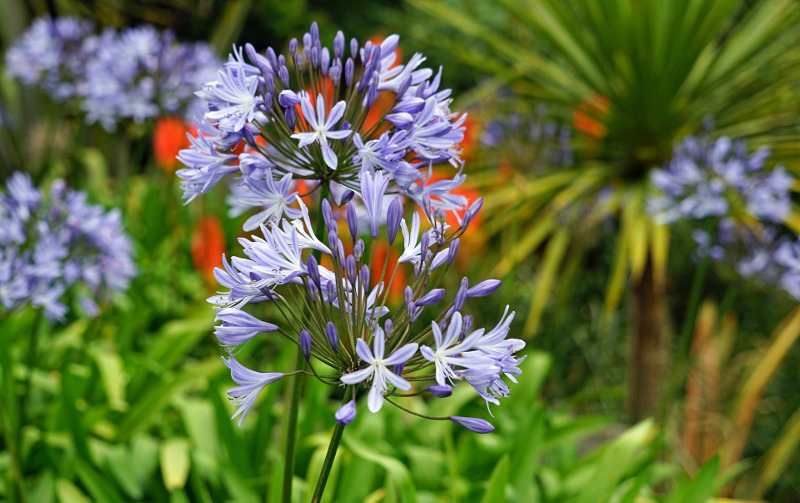Expanding Agapanthus: A Full Guide to Beautiful Blooms
Expanding Agapanthus: A Full Guide to Beautiful Blooms
Blog Article
Mastering the Art of Agapanthus Treatment: Vital Steps for Healthy And Balanced Growth and Dynamic Blooms
In the realm of cultivation, the growing of agapanthus stands as a satisfying venture for those who look for to nurture these elegant flowering plants. From selecting the right range to grasping pruning techniques, the journey towards growing thriving agapanthus plants is complex and holds the key to unlocking the complete capacity of these botanical treasures.

Selecting the Right Agapanthus Range

When choosing the best Agapanthus range for your yard, take into consideration variables such as environment viability, flower shade, and growth practice. Agapanthus, generally known as Lily of the Nile or African lily, is available in a range of shades ranging from shades of blue and purple to white. Pick a blossom shade that enhances your existing garden scheme to develop an unified landscape. Additionally, think about the climate in your region to make certain the Agapanthus variety you pick can prosper in your particular conditions. Some selections are a lot more forgiving of cold temperature levels, while others favor warmer climates. Comprehending the development habit of various Agapanthus ranges is crucial for proper positioning within your yard. Some ranges have a clumping growth behavior, perfect for containers or borders, while others have an even more dispersing nature, ideal for ground cover or mass plantings. By very carefully reviewing these elements, you can select the ideal Agapanthus range to improve the elegance of your garden.
Suitable Planting Problems
Taking into consideration the ideal ecological demands is necessary for effective Agapanthus cultivation. Agapanthus plants are sensitive to cold temperatures and need to be secured from frost throughout winter months.
To make certain healthy and balanced development and vibrant blooms, plant Agapanthus bulbs at a depth of about 2-4 inches and room them 8-12 inches apart. Adding organic matter, such as garden compost, to the soil can improve drainage and fertility, advertising robust root advancement. Mulching around the base of the plants assists retain wetness and subdues weed development. Routine watering is vital, specifically during the growing season, to maintain the soil constantly wet however not saturated.
Watering and Fertilizing Tips
Maintaining appropriate wetness degrees and providing vital nutrients are vital aspects in the care regimen for Agapanthus plants. When it comes to watering Agapanthus, it is crucial to strike an equilibrium. These plants prefer constantly wet soil yet are vulnerable to root rot if overwatered.
Fertilizing Agapanthus is important for advertising healthy and balanced development and respected blooms. Apply a well balanced fertilizer, such as a 10-10-10 formula, in the early springtime as brand-new growth arises. By following these watering and feeding pointers, you can ensure your Agapanthus plants prosper and create vivid, durable flowers.
Pruning Strategies for Agapanthus
Pruning Agapanthus plants at the suitable times and with appropriate techniques is crucial for keeping their wellness and promoting ideal development and blooming. The excellent time to prune Agapanthus remains in late winter months or early spring before new development emerges. Beginning by getting rid of any type of dead or yellowing leaves near the base of the plant. Cut them as short as possible without damaging the emerging shoots.
For flowered stems, wait till the flowers have withered and then trim them back to the base. This not just cleans up the plant's look but likewise encourages the advancement of brand-new flower buds. Deadheading spent flowers can additionally redirect the plant's energy into creating even more blossoms as opposed to setting seeds. Nevertheless, if you desire to collect seeds for breeding, leave some flowers to mature and completely dry on the plant.
Bear in mind to make use of clean, sharp devices to make exact cuts and lower the threat of introducing diseases. Agapanthus. Routine trimming will certainly assist maintain your Agapanthus looking cool and healthy and balanced while making certain a plentiful display of beautiful blossoms
Dealing With Typical Pests and Conditions
After making certain appropriate trimming techniques for Agapanthus, it is important to attend to usual pests and diseases that can influence the health and vitality of original site these plants. Agapanthus plants are generally hardy but can still succumb to certain concerns. One this link common insect that influences Agapanthus is the Agapanthus gall midge. This tiny, orange fly lays its eggs in the foliage, bring about altered development and blossom buds that fail to open up. To combat this bug, trim and damage any kind of damaged plant parts and consider utilizing insecticidal soap.
Furthermore, Agapanthus plants can suffer from root rot if they are grown in badly draining pipes soil. By being alert and taking timely activity versus insects and illness, you can help your Agapanthus plants flourish and create vibrant flowers. Agapanthus.

Final Thought
In conclusion, understanding the art of agapanthus treatment involves choosing the appropriate range, supplying excellent planting problems, correct watering and fertilizing, appropriate pruning methods, and dealing with typical pests and diseases. By adhering to these essential actions, you can make sure healthy and balanced growth and dynamic blooms for your agapanthus plants. Remember to on a regular basis check and keep your plants to advertise their total well-being and long life.
To ensure healthy and balanced growth and lively blooms, plant Agapanthus bulbs at a deepness of concerning 2-4 inches and space them 8-12 inches apart. By following these watering and feeding pointers, you can ensure your Agapanthus plants flourish and produce dynamic, resilient blooms.
One typical bug that influences Agapanthus is the Agapanthus gall midge. In addition, Agapanthus plants can suffer from origin rot if they are planted in inadequately draining pipes soil. By complying with these necessary actions, you can pop over here make certain healthy and balanced growth and vibrant flowers for your agapanthus plants.
Report this page